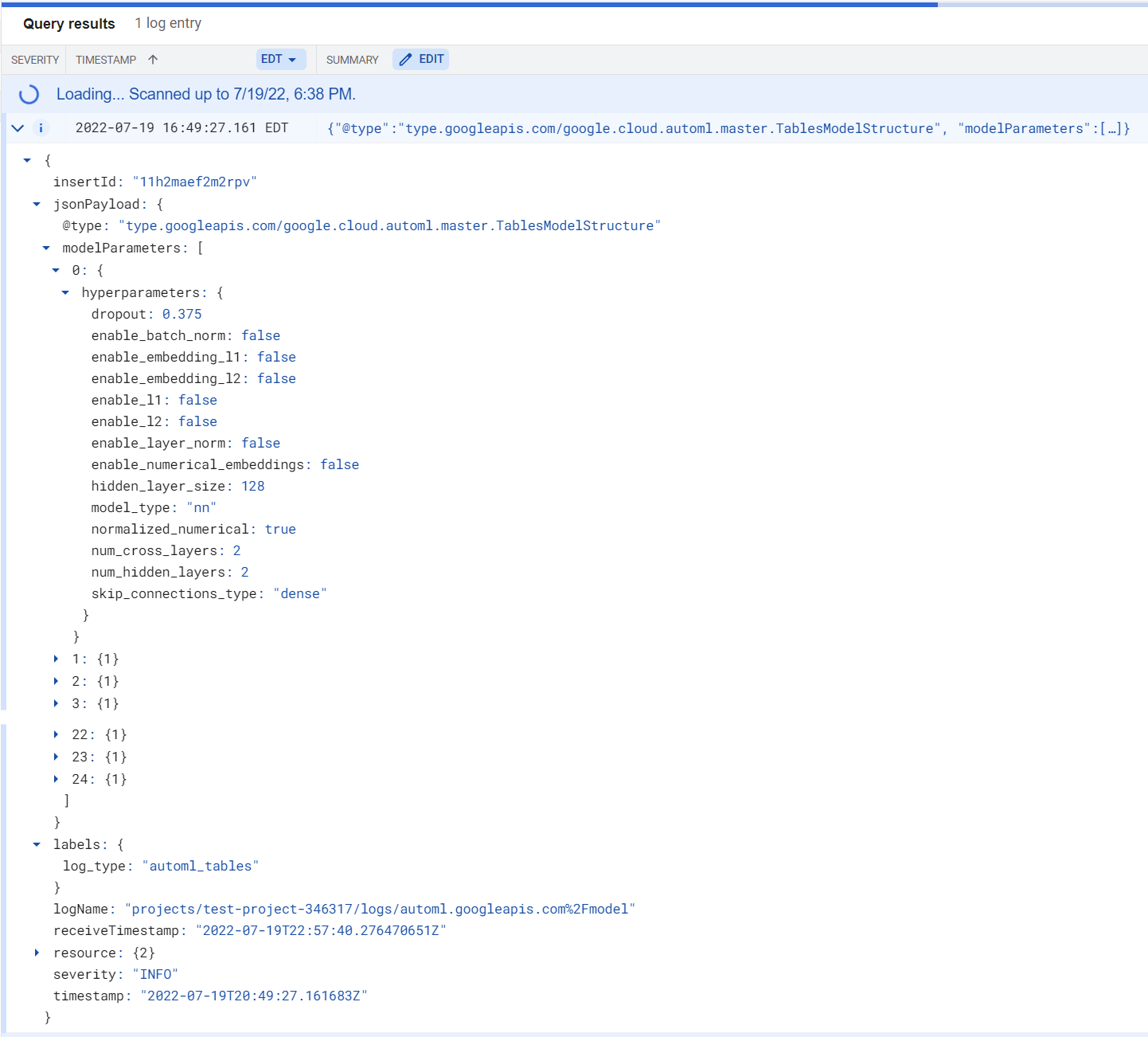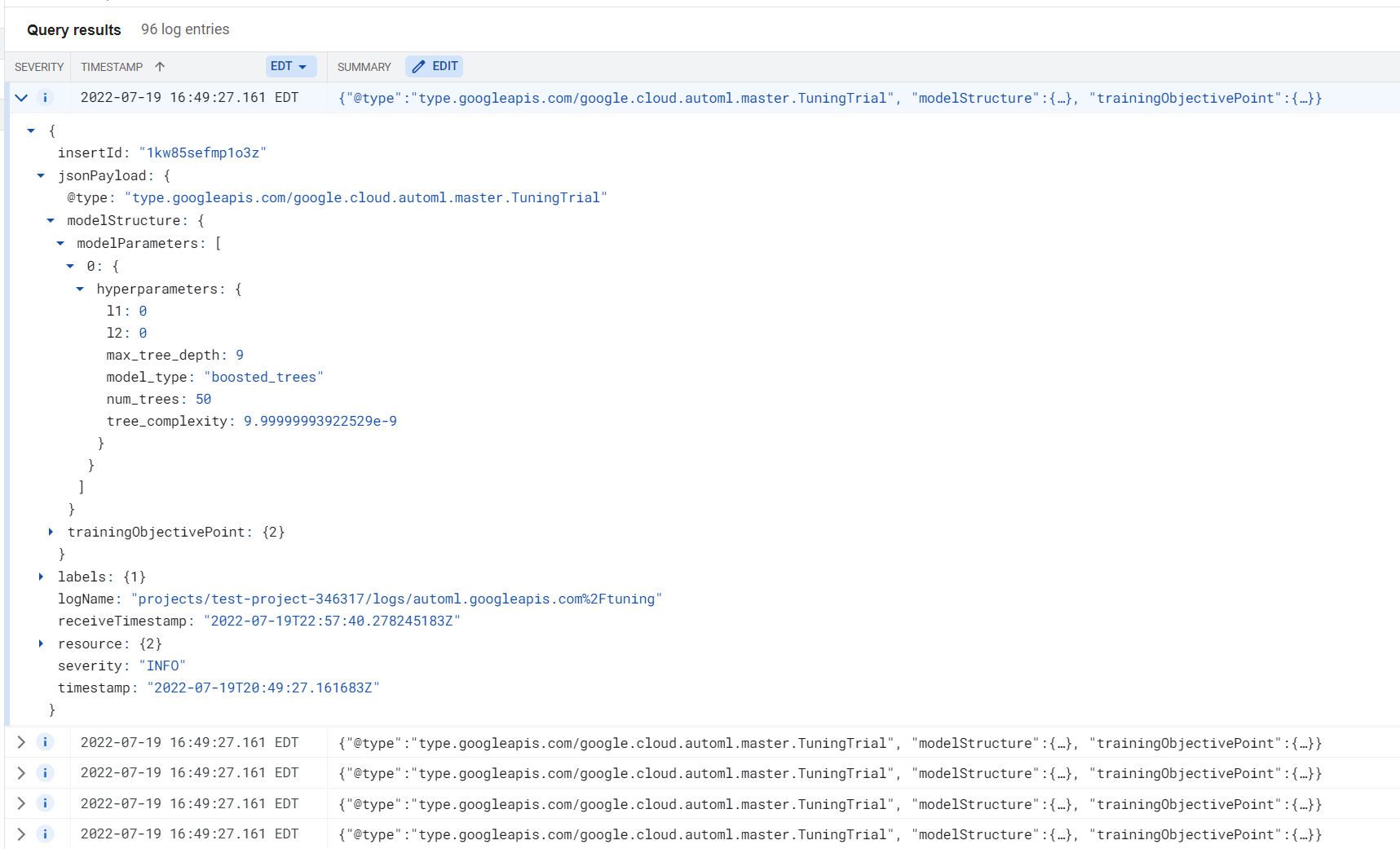Nesta página, você aprenderá a usar o Cloud Logging para conferir detalhes sobre um modelo do Vertex AI. Usando o Logging, você vê:
- Os hiperparâmetros do modelo final como pares de chave-valor.
- Os hiperparâmetros e valores de objeto usados durante o treinamento e o ajuste do modelo, bem como um valor de objetivo.
Por padrão, os registros são excluídos após 30 dias.
Os seguintes tópicos são abordados:
Antes de começar
Antes de ver os registros de hiperparâmetros do seu modelo, é preciso treiná-los.
Para executar esta tarefa, é necessário ter as permissões abaixo:
logging.logServiceIndexes.listno projetologging.logServices.listno projeto
Como ver registros de treinamento
É possível usar o console Google Cloud para acessar os registros de hiperparâmetros do modelo final e os registros de hiperparâmetros dos testes de ajuste.
No console Google Cloud , acesse a página Modelos da Vertex AI.
Na lista suspensa Região, selecione a região em que seu modelo está localizado.
Na lista de modelos, selecione o modelo.
Selecione o número da versão do seu modelo.
Abra a guia Detalhes da versão.
Para ver o registro de hiperparâmetros do modelo final, acesse a linha Hiperparâmetros do modelo e clique em Modelo.
Há apenas uma entrada de registro. Expanda o payload, conforme exibido abaixo. Veja mais detalhes em Campos de registro.

Para ver o registro de hiperparâmetros dos testes de ajuste, acesse a linha Hiperparâmetros do modelo e clique em Testes.
Há uma entrada para cada um dos testes de ajuste. Expanda o payload, conforme exibido abaixo: Veja mais detalhes em Campos de registro.

Campos de registro
Os registros de atividades são estruturados conforme descrito na documentação do tipo LogEntry.
Os registros do modelo do Vertex AI têm, entre outros campos:
labels: o campolog_typeestá definido comoautoml_tables.jsonPayload: os detalhes específicos da entrada de registro, fornecidos no formato de objeto JSON. Para ver detalhes, consulte Conteúdo do payload para o registro de hiperparâmetros do modelo final ou Conteúdo do payload para o registro de hiperparâmetros de um teste de ajuste (em inglês).timestamp: data e hora em que o modelo foi criado ou o teste foi executado.
Conteúdo de payload para o registro de hiperparâmetros do modelo final
O campo jsonPayload para o registro de hiperparâmetros do modelo final contém um campo modelParameters. Esse campo contém uma entrada para cada modelo que
contribui com o modelo do conjunto final. Cada entrada tem um campo hyperparameters, com conteúdo que depende do tipo de modelo. Para mais detalhes, consulte Lista de hiperparâmetros.
Conteúdo de payload para o registro de hiperparâmetros de um teste de ajuste
O campo jsonPayload do registro de hiperparâmetros de um teste de ajuste contém os seguintes campos:
| Campo | Tipo | Descrição |
|---|---|---|
modelStructure |
JSON |
Uma descrição da estrutura do modelo do Vertex AI.
Este campo contém um campo |
trainingObjectivePoint |
JSON | O objetivo de otimização usado para treinamento de modelos. Essa entrada inclui um carimbo de data/hora e um valor de objetivo do momento em que a entrada de registro foi gravada. |
Lista de hiperparâmetros
Os dados de hiperparâmetros fornecidos nos registros são diferentes em cada tipo de modelo. As seções a seguir descrevem os hiperparâmetros em cada tipo de modelo.
Modelos de árvore de decisão aprimorados por gradiente
- Regularização da árvore L1
- Regularização da árvore L2
- Profundidade máxima da árvore
- Tipo de modelo:
GBDT - Número de árvores
- Complexidade da árvore
Modelos de rede neural do feedforward
- Taxa de dropout
- Ativar batchNorm (
TrueouFalse) - Ativar a incorporação L1 (
TrueouFalse) - Ativar a incorporação L2 (
TrueouFalse) - Ativar L1 (
TrueouFalse) - Ativar L2 (
TrueouFalse) - Ativar layerNorm (
TrueouFalse) - Ativar incorporação numérica (
TrueouFalse) - Tamanho das camadas escondidas
- Tipo de modelo:
nn - Normalizar coluna numérica (
TrueouFalse) - Número de camadas cruzadas
- Número de camadas escondidas
- Ignorar tipo de conexões (
dense,disable,concatouslice_or_padding)
A seguir
Quando estiver pronto para fazer previsões com o modelo de classificação ou regressão, você terá duas opções:
- Faça previsões on-line (em tempo real) usando seu modelo.
- Receba previsões em lote diretamente do modelo.
Você também pode:
- Avalie o modelo.
- Leia as informações gerais sobre o Cloud Logging.
- É possível exportar seus registros para o BigQuery, para o Cloud Storage ou para o Pub/Sub. Leia Rotear registros para destinos compatíveis na documentação do Logging para saber como exportar registros de atividades.

